T51p
back to Beyerdynamic
back to measurements
home
Published: Oct-17-2018
NO SMOOTHING is applied to the shown plots. Most measurement sites have some smoothing applied which ‘irons flat’ sharp peaks and ‘wiggles’. I do not use smoothing because some info about sound quality is lost when plots are smoothed.
Aside from a small correction of the microphone itself also some correction in the lowest frequencies is applied to the plots to compensate for the perceived loss of bass when using headphones. This is described HERE in more detail.
A ‘horizontal‘ frequency response curve on the shown frequency response plots on this website thus indicates a perceived ‘flat’ tonal signature.
ALL measurements are made with a good SEAL on a flatbed measurement rig.
The shape of your head, bone structure, pad size, pad ‘softness, (compliance), hair or no hair and or wearing glasses may (drastically) change the frequency response of some headphones, so… your personal experience may differ substantially from these plots.
Frequency response (tonal balance) is the most sound-determining aspect of headphones. A horizontal line shows audible neutral response in the plots on this website. Deviations in different severities at different frequency bands have an effect on the sound character.
The bigger the deviation the stronger the effect.
Below an aid to help determining the sound character of headphones with relation to the frequency response.

Beyerdynamic T51p

The Beyerdynamic T51p is a closed on-ear (supra aural) dynamic headphone.
It is the same headphone as the T51i but that one has a cord with a 3-button apple remote.
It is the successor of the not so great T50p with some features of the DT1350.
To me it is an improvement over both headphones when it comes to sound quality.
It is supposed to compete with the venerable Sennheiser HD25 but don’t see many common points with this headphone.
This is an on-ear headphone. The clamping force is decent so it does not fall off the ears when moving around nor does it crush the ears and cause discomfort (at least not to me).
The T51P looks like a composition of the DT1350 (headband) and T50p when it comes to the colours cheme.
It looks and feels solid and high quality. The split headband of the DT1350 is also present in the T51P.
It is a bit easier to get a proper fit (and thus good sound) with the T51p than it was with the T50p.
The headphone cable is 1.3m long and quite thin. Alas it is microphonic as well as the cups and headband. When the cable rubs against clothes and when you touch it this is quite audible in the ear cups.
The DT1350 had a single sided cable, the T51p has a split cable. The advantage here is that there is no need for a (thin) cable to run from the left to the right cup.
The efficiency is very high so it can play very loud even from portable sources like phones etc.
This headphone is very lightweight which makes it quite comfortable as far as on-ear headphones are.
specifications:
Type: On-ear, closed
Usage: Home, Studio, Portable
Isolation: decent, 22dBA
Driver type: dynamic, Tesla
Pads: replaceable, pleather (faux leather)
Pad dimensions: ∅ 65mm
Collapsible: No, but can fold flat
Headphone connector: fixed
Cable entry: fixed, dual sided
Cable: 1.3m terminated in 3.5mm TRS with 6.3mm adapter.
Driver size: ø 32mm
Nom. power rating: 0.1W (100mW)
Max. voltage: 1.8V
Max. current: 100mA
Max. S.P.L.: 131dB
Impedance: 32 Ω
Efficiency: 110dB @ 1mW
Sensitivity: 125dB @1V
Weight: 174 g.
Colour: steel with black accents
Clamping force: medium
Accessories: 6.3mm adapter, airline adapter and carrying case.
Sound description:
The T51p has a very ‘open’ and dynamic sound. It is slightly boomy but the bass is of good quality. The mids are sounding open and forward and are of good quality as well.
The sound is much ‘bigger’ than one would expect of these small sized headphones.
There is a small emphasis on the treble (as with most Beyerdynamic’s) but is not sibilant or harsh.
Probably caused by its high sensitivity, the sound ‘falls apart’ on higher listening levels.
It starts to sound less ‘accurate’ and ‘nice’ in that case.
On normal levels the T51p sounds surprisingly good. One condition to get good sound, as is also the case with the DT1350, and even much more so in the T50p, is that a good positioning and seal is paramount. Shift it a few cm and the sound quality is down the drain. Perfect positioning is essential.
measurements:
Below the frequency response of the T51p (Left, Right)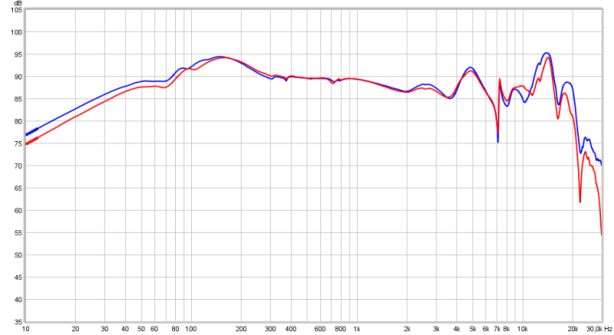 Channel matching is excellent. There is a small boost around 150Hz which gives the bass some ‘body’ to it but also makes bass a bit boomy. Bass extension is flat to 40Hz. It drops off slowly below that point.
Channel matching is excellent. There is a small boost around 150Hz which gives the bass some ‘body’ to it but also makes bass a bit boomy. Bass extension is flat to 40Hz. It drops off slowly below that point.
The mids sound excellent and ‘natural’. ‘open’ and ‘forward and detailed. This sound quality of the mids rivals that of more expensive headphones.
The narrow peaks at 5kHz and 13kHz aren’t very audible in a negative way. They do contribute to the ‘detailed’ yet not sibilant character of this headphone.
Seal
Seal is quite important for closed headphones and this headphone is no exception. As this is an on-ear glasses etc. do not change the seal but hairs and shape of the Pinna become important factors. Below the effect on the sound is shown when the seal is not perfect. The bass suffers. It is the reason why the current pads are bit bigger and wider and softer so they conform better to the shape of the Pinna. Perfect seal, small seal loss, substantial seal loss.
Comparison with T50p and DT1350
Below the T51p vs the T50p. The tonal balance of the T51p is more neutral. The T50p has a small ‘hump’ between 200Hz and 800Hz which gave it a ‘hollow’ character to its sound.
The T50p also was a lot bassier sounding and was a bit ‘rougher’ in the treble, as in not very refined.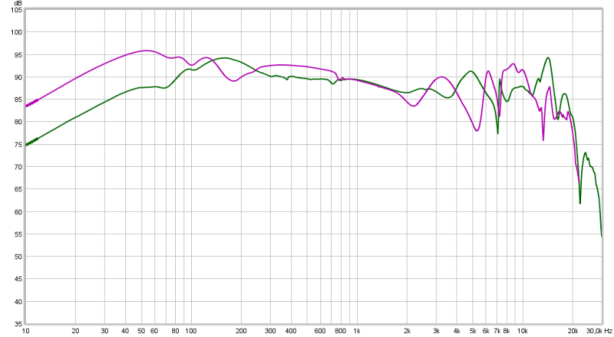
Below the T51p vs the DT1350 with the smaller pads the original DT1350 came with. On later DT1350’s the pads were changed to slightly bigger ones similar to those on the current DT1350/T51p.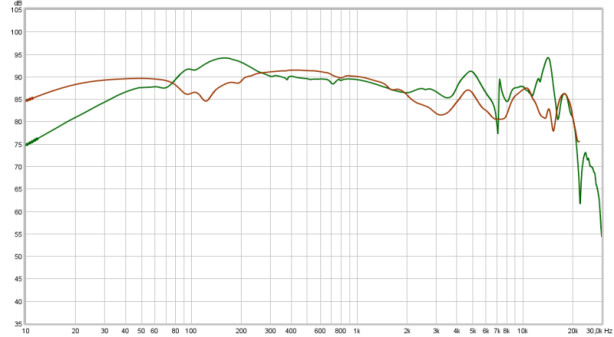 The DT1350 does have better bass extension but is more ‘mid-centric’ and somewhat less ‘present’ in the upper mids and treble.
The DT1350 does have better bass extension but is more ‘mid-centric’ and somewhat less ‘present’ in the upper mids and treble.
Of these 3 headphones I prefer the sound and comfort of the T51p over that of the DT1350. The T50p was a bit of a disappointment.
output resistance / damping-factor
As this is a dynamic headphone the frequency response might be amplifier output resistance dependent when certain higher output resistance amplifiers are used.
To test this the headphone is measured via a low impedance amplifier (0.2Ω) and a high impedance amplifier (120Ω).
On a higher output resistance amplifier the output level will be considerably lower. To compensate for this the amplifier is cranked up to the same level (17dB at 1kHz) as the low impedance amplifier. This way the plots are overlay-ed and it is easier to show the tonal balance differences. The headphone does not react very favorably to higher output resistances. Bass becomes a bit ‘woolly’ and pronounced. I would recommend to use amplifiers/sources with an output resistance below 10Ω.
The headphone does not react very favorably to higher output resistances. Bass becomes a bit ‘woolly’ and pronounced. I would recommend to use amplifiers/sources with an output resistance below 10Ω.
Below the distortion measurements of the T51p (Right channel)
Below the same distortion plot but with the vertical scale in percentages instead of level differences. 
The 3rd harmonic distortion around 60Hz is reaching 2% and is indicative of ‘clipping’ alike non-linear behavior. From 200Hz up the distortion is well below 0.1%.
Higher distortion levels at lower frequencies are not really that audible as such so everything below 1% is good.
The 2nd harmonic distortion is probably lower than shown as limits of the test rig are around 0.2%.
The higher distortion around 2.5kHz is not an error though.
Below the CSD of the T51p. (Left and Right are superimposed) Aside from the substantial ringing at 7kHz (which is also visible in the frequency response) the CSD is quite nice. Ringing at 7kHz can be audible, certainly when one is listening to it for a longer period. In the short time I heard it I did not pick up on it though.
Aside from the substantial ringing at 7kHz (which is also visible in the frequency response) the CSD is quite nice. Ringing at 7kHz can be audible, certainly when one is listening to it for a longer period. In the short time I heard it I did not pick up on it though.
Below the spectrum plot of the T51p (Right channel). There is some lingering around 700Hz (which could possibly be the small enclosure), a short one around 2.6kHz (which is inaudible) and the obvious ringing around 7kHz which stands out. Just above 10kHz there are some very small ones that are also of no importance.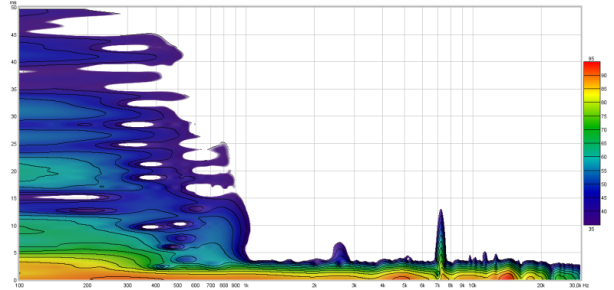
The step response plot below shows the impulse response is quite good. The initial rise almost reaches 0dB and there is no overshoot nor undershoot. Also there is no evidence of ‘coloration’ to the sound signature. 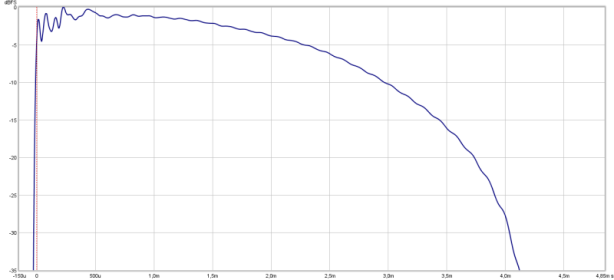 The two things that do stand out is the lack of bass extension as the trace starts to drop off after 2ms quite steep. Another thing that is quite obvious is the ringing at 7kHz which starts directly after the impulse and is still visible after 4ms.
The two things that do stand out is the lack of bass extension as the trace starts to drop off after 2ms quite steep. Another thing that is quite obvious is the ringing at 7kHz which starts directly after the impulse and is still visible after 4ms.
summary
The Beyerdynamic T51p isn’t a cheap portable headphone. It also doesn’t look, feel nor sound cheap either. In fact, aside from the slight lack of bass extension sounds very good and dare to say there are more expensive headphones it puts to shame.
No, the T51p isn’t perfect. The microphonic cable, the need for a proper seating on the head (seal) and the fact that the sound breaks-up at higher SPL aren’t the best assets it has. It’s what keeps me from replacing the DT1350.
The T51i is the same headphone but it has a 3-button remote in it which only works on apple devices.
All in all a very good sounding small and portable headphone with a good build quality and looks which, for an on-ear headphone, is quite comfortable.
The sound quality is excellent (analytical and flat, as in realistic) BUT you need a good fit and positioning. For these reasons I recommend you really TRY it before you buy it or can send it back without additional costs. Like the DT1350 this headphone certainly is not suited for everyone.
